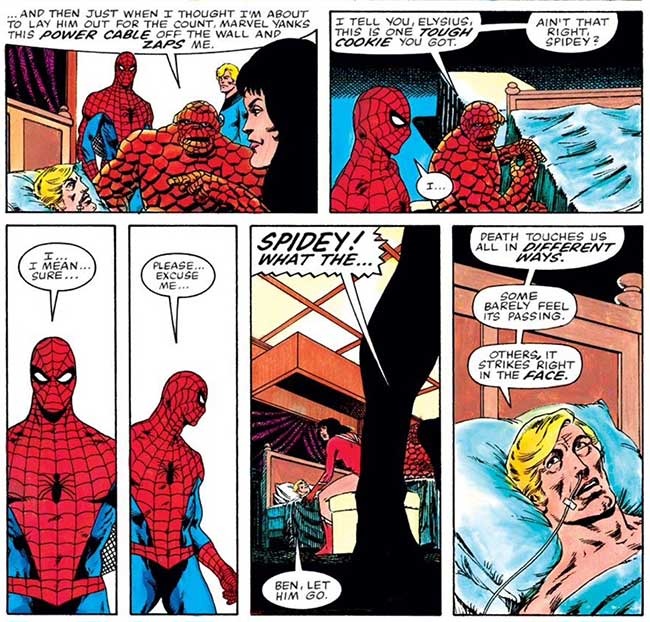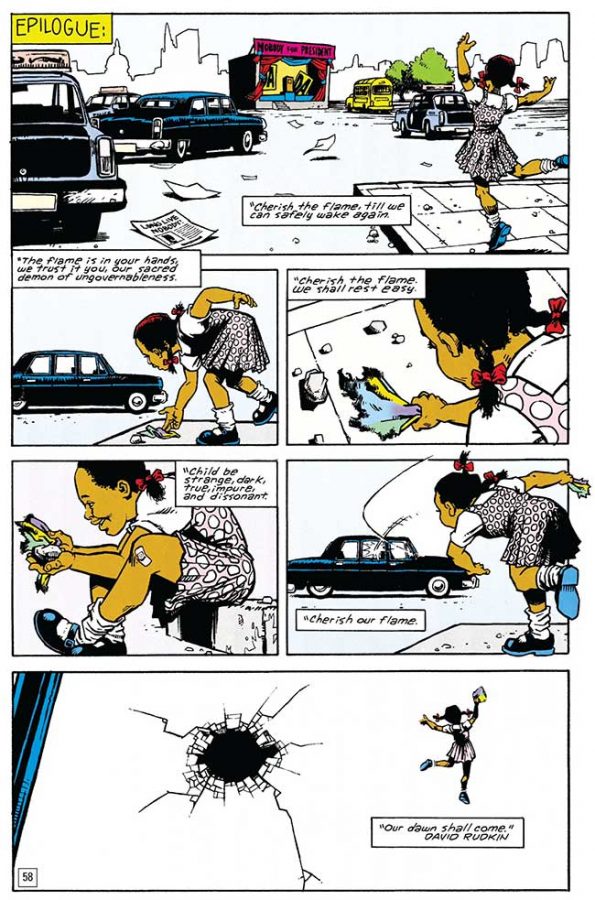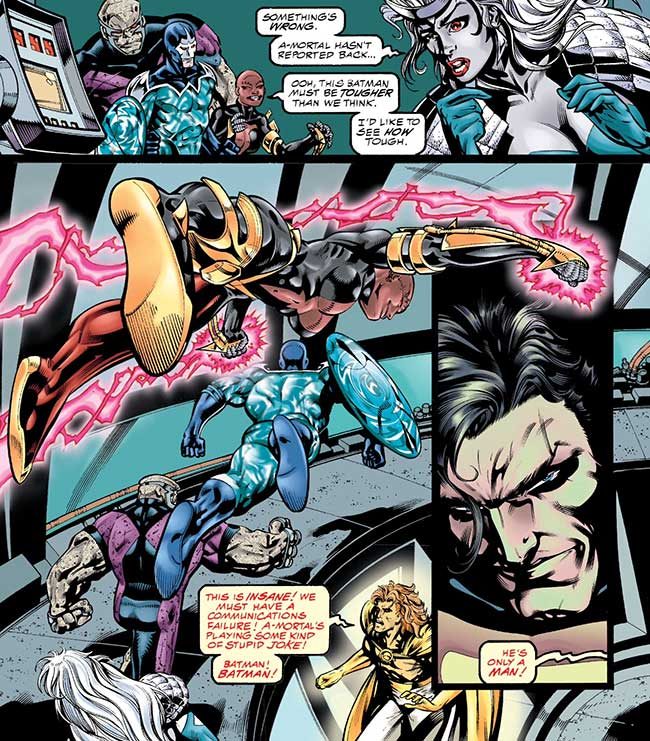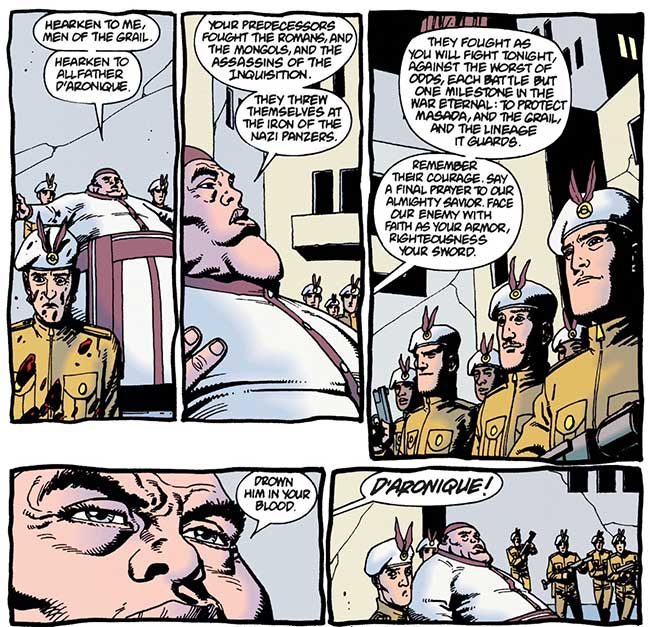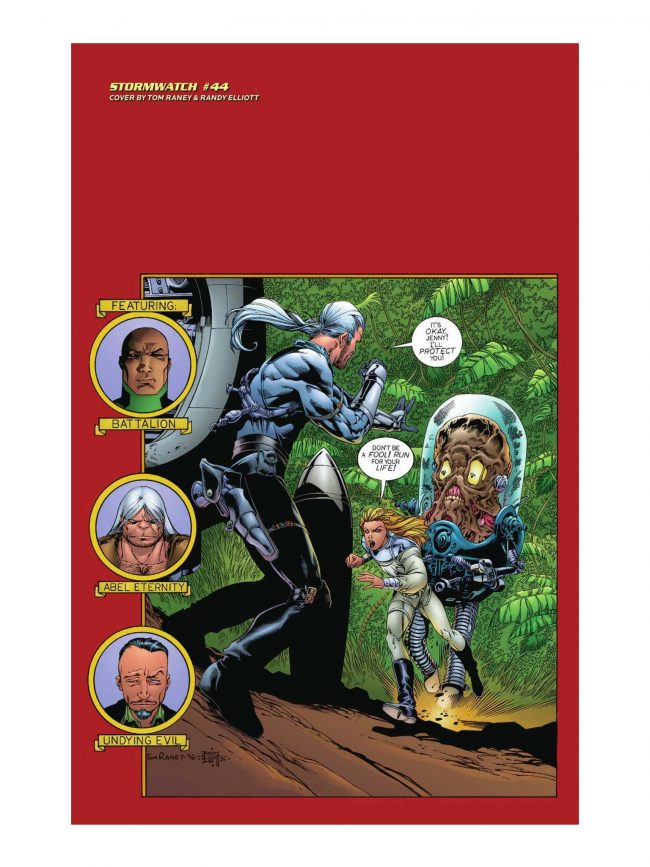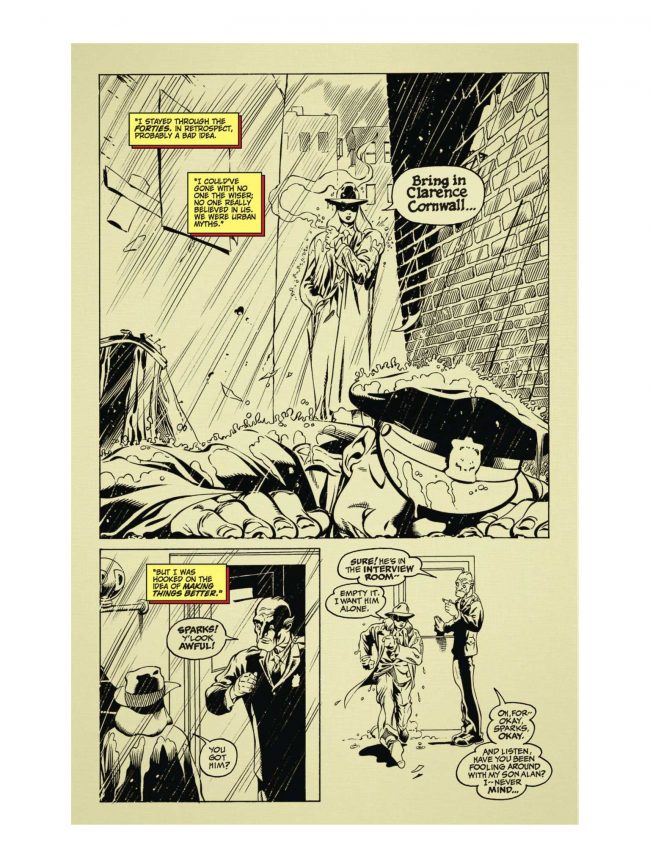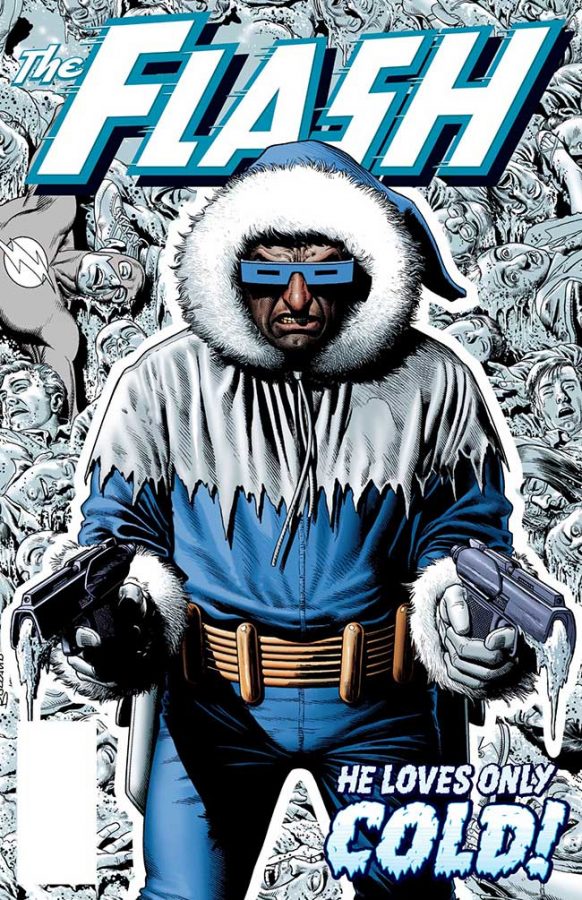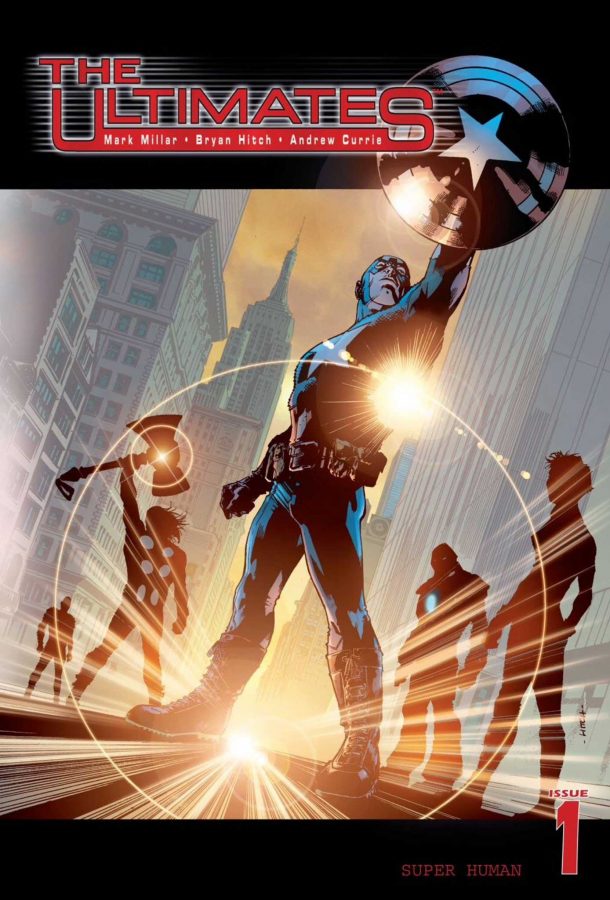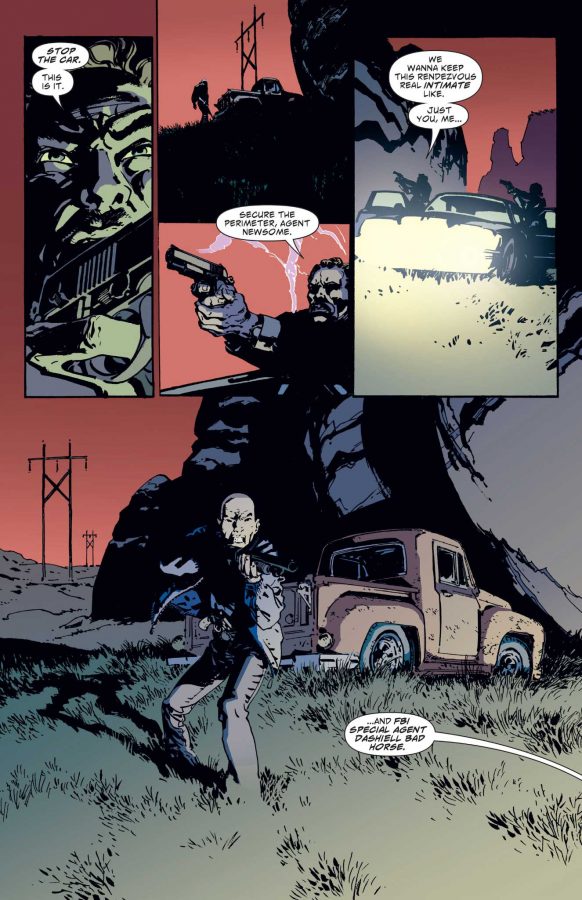Rand Bellavia of Ookla the Mok fame, returns this month with a new installment of Random Access Memory.
Author’s Note: Random Access Memory is me looking back at the specific comics that shaped my life. Each month I go back in time – in five year intervals – to examine key comics that came out those months. (The idea is that after five years of monthly columns, I will have covered an entire lifetime – in this case, fifty years – of reading comics.) I also list all the comics I read that particular month. This will afford readers the opportunity to chastise me for not reading specific comics, and/or laugh at the horrible, horrible choices I made in the past.
January 1977
Avengers 158
I grew up an era without comic book stores. We were hunter-gatherers, seeking out comics in the wild – which is to say, mostly in spinner-racks at pharmacies, gas stations, and grocery stores. Back issues were a distant dream – obtained primarily by begging your parents to stop the car whenever you saw a “garage sale” sign and hoping you got lucky. On top of all this, I grew up in a rural environment – a fifteen minute drive from even the smallest town. All of this conspired to keep me from getting anywhere near to a full run of my favorite comics – until, at eight years old, I had the best idea of my young life, and asked my parents to get me a subscription to the Avengers for Christmas.
Avengers 158 was the first issue of that subscription. Bronze Age Avengers fans can think back to the issues that followed – The Bride of Ultron, Count Nefaria, The Korvac Saga – and realize how lucky I was to randomly obtain these 12 issues. Needless to say, it solidified my love of comics. In many ways, you could say that the 12 issues of the Avengers that begin with this issue are the reason I’m here today. (Here writing this column, of course – not here on earth. I’m not a lunatic.)
While most of the issues in my subscription were illustrated by George Perez or John Byrne, the first one was drawn by the underrated Sal Buscema. It opened with a super-hero fight that (according to the cover) “had to happen” – The Vision vs. Wonder-Man.
For those not in the know, super-hero fights were rather de rigueur at the time. They occurred so frequently, in fact, that even the characters failed to be impressed or concerned.
Check it out: The Vision just put his hand *through* Wonder-Man’s chest – understandably causing him great pain and consternation – and Iron Man’s “just let them fight it out” couldn’t be more blasé.
Later on, we are introduced to Graviton, a new villain who takes out the Avengers with relative ease.
What will happen next? For the first time in my life, I could relax knowing I’d be sure to find out.
Other Comics I Read From January 1977
- Action Comics 470
- Green Lantern 94
- Spidey Super Stories 22
- Superboy and the Legion of Super-Heroes 226
January 1982
Marvel Graphic Novel: The Death of Captain Marvel
The debut of Marvel’s Graphic Novel line. These volumes were fairly thin (usually 50-80 pages) but published in a larger format (8 ½” x 11”) than usual comics. Most importantly, as this was long before comics were collected into trade paperbacks on a regular basis, they contained all original material.
Most of the volumes in this line contained original characters, three of the first five Marvel Graphic Novels published were stand-alone stories featuring Marvel Super-Heroes – the other two being the launch of the New Mutants and the infamous “God Loves, Man Kills” X-Men graphic novel.
This graphic novel was written and illustrated by Jim Starlin, the man primarily responsible for Kree Super-Soldier Mar-Vell’s popularity, and – as the title promises – Captain Marvel dies at the end. What made this death particularly poignant was that he didn’t die in battle with some cosmic Super-Villain but fell to a more mundane – and relatable – foe.
For most of the book, Mar-Vell lies on his deathbed while his friends alternate between seeking a cure and attempting to comfort him. This doesn’t sound very interesting, but seeing how various Marvel heroes react to Mar-Vell’s impending death is fascinating.
The unexpected arrival of a Skrull General leads to a particularly powerful moment.
In the end, Mar-Vell is given a death so honorable that 35 years later Marvel continues to let him rest in peace.
What If 32
Korvac was an all-powerful being who sought to bring order to the world – by force, of course – only to find himself facing the Avengers (pretty much ALL of them, along with the original Guardians of the Galaxy and a decent chunk of the rest of the Marvel Universe) for his troubles. Having pretty easily dispatched the Avengers, he has a brief moment of doubt, and allows himself to be defeated, using the last of his power to bring the Avengers back to life. Because, reasons. But, what if, in some alternate universe, Korvac had won?
Apparently, that entire universe (literally) would react to him the same way the Avengers did. And – lacking the empathy he showed on Earth-616 – Korvac would respond in kind.
This comic – written and illustrated by Mark Gruenwald – introduced me to a whole host of insanely powerful characters that exist on the fringes of the Marvel Universe: Master Order, Lord Chaos, The Stranger, The Gardener, The Living Tribunal, The Grandmaster, The Shaper of Worlds, The In-Betweener…

It also brought back the Ultimate Nullifier, first shown in the classic Kirby-Lee Fantastic Four story that introduced the Silver Surfer and Galactus. As the Ultimate Nullifier tries to warn you with its name, it will… well, ultimately nullify whoever you aim it at. There are, however, two caveats: 1.) activating it requires a massive amount of will, and 2.) the device will ultimately nullify the person holding the device along with the ultimate nullifiee.
Korvac sends Captain America (after killing all of Earth’s Super-Heroes, Korvac brings them back to life as his servants, and… you don’t really want me to recount the entire plot, do you?) to retrieve the Ultimate Nullifier and use it against Galactus.
 You can say Ultimate Nullifi-a, but you can’t say Ultimate Nullifi-er.
You can say Ultimate Nullifi-a, but you can’t say Ultimate Nullifi-er.
And, of course, on the final page, Korvac reminds us that we’re reading an issue of What If.
 I hear Uatu in that voice from the end of Beneath the Planet of the Apes.
I hear Uatu in that voice from the end of Beneath the Planet of the Apes.
Other Comics I Read from January 1982
- Amazing Spider-Man 227
- Avengers 218
- Captain America 268
- Cerebus 34
- Daredevil 182
- Ka-Zar 14
- Marvel Team-Up 116
January 1987
Cerebus 94
Cerebus’ infamous second marriage. Most of this issue is a conversation between Pope Cerebus and political rival Astoria, who he has had imprisoned.
The rape of Astoria is, of course, the moment when Cerebus crosses the line from an anti-hero who is making increasingly hard to justify decisions to a full-on super-villain. This also coincides – certainly not by mistake – with the beginning of his long (over 200 issues!) slide from power into misery, where he eventually dies “alone, unmourned and unloved.”
Question 3
This issue continues the Reverend Hatch storyline that climaxes in issue four, and has a pretty good “terrorist trying to blow up a school bus” action set piece, but it’s the last page that sets the tone for what is to come – introducing the “be here now” Zen Buddhism that would make Victor Sage one of the most interesting Super-Hero of the eighties, and The Question my favorite super-hero comic of 1987.
Swamp Thing 59
Penciler Steve Bissette returns to Swamp Thing for one issue, but this time as a writer. Bissette brings back Abbey’s father Gregori, AKA the Patchwork Man, last seen in 1972 – in the third issue of Len Wein and Bernie Wrightson’s original run of Swamp Thing. In some ways, the Patchwork Man is a blatant Frankenstein rip-off – after stepping on a land mine, Gregori’s brother (and Swamp Thing nemesis) Anton Arcane patched him back together and brought him back to life, apparently proving that flattening out the top of the skull is the secret to reanimation – but Bissette runs with the pathos that Wein invested into the character, and when Gregori and Abbey are finally reunited, he provides one of the more emotionally powerful moments of the series.
Other Comics I Read from January 1987
- Action Comics 587
- Alien Legion 18
- American Flagg 40
- Avengers 278
- Badger 23, 24
- Chronicles of Corum 3
- Classic X-Men 8
- Demon 4
- Dreadstar 30
- Elektra: Assassin 7
- Grendel 4
- Justice League of America 261
- Legends 6
- Nexus 32, 33
- Scout 15
- Vigilante 40
- Watchmen 8
- X-Men vs. the Avengers 2
- Yummy Fur 2
January 1992
Doom Patrol 52
This issue features the big showdown between Mr. Nobody’s new Brotherhood of Dada and the somehow more preposterously-named – and the surprisingly violent – Yankee-Doodle, with our heroes standing ineffectively on the sidelines, wondering who the bad guys really are. Is this the end of Mr. Nobody? (Spoiler Warning: Probably.)
Just in case you hadn’t picked up on the “agents of chaos might not necessarily be the bad guys” vibe of the last few issues, this issues opens with The Brotherhood of Dada sharing a “last supper” together.
By the end of the issue, The Brotherhood of Dada are dead, and Mr. Nobody hangs on just long enough for Robot Man to show up so they can recreate the Pieta.

The final page of the issue is a beautiful nod to the last page of Roy Thomas and John Buscema’s Avengers 58.
Other Comics I Read from January 1992
- Animal Man 45
- Batman: Legends of the Dark Knight 28
- Beautiful Stories for Ugly Children 25
- Cerebus 154
- Hate 7
- Hellblazer 51
- Incredible Hulk 391
- Shade the Changing Man 21
- Peter Parker the Spectacular Spider Man 185, 186
- Swamp Thing 117
- X-Factor 76
- Yummy Fur 27
January 1997
JLA 3
As super-hero team comics often do, the last issue ended with the Hyperclan having captured or otherwise disposed of the individual members of the JLA. This one opens with the revelation that Batman is still at large.
More than a decade later, Grant Morrison would squeeze nearly 80 issues of Batman comics out of that look on Superman’s face.
Another great moment in this issue is the return of the Flash Fact.
Preacher 23
Another issue of Preacher, and another perfect comic book page.
Meanwhile, the Allfather of the Grail shows a tragic disregard for the sanctity of human life.
Stormwatch 44
Jenny Sparks was born on January 1, 1900, and died on December 31, 1999. In this issue, she shares her life story, giving Warren Ellis and Tom Raney the opportunity to offer a crash-course in 20th century comics history. In the 1930s, her adventures looked remarkably like those of Siegel and Shuster’s Golden Age Superman.
By the 1940s, she looked suspiciously like she was drawn by Will Eisner.
In the sixties, she split her time between R. Crumb and Jack Kirby.
And by the late eighties, life was reduced a nine-panel grid, and appeared to be illustrated by Dave Gibbons.
Other Comics I Read from January 1997
- Aztek 8
- Batman: Legends of the Dark Knight 92
- Batman: The Long Halloween 4
- The Big Book of Losers
- Black Lamb 5
- Cerebus 214
- Flash 123
- Heartland
- Hellblazer 111
- Hitman 12
- Impulse 23
- Invisibles 2
- Kurt Busiek’s Astro City 4
- Seekers: Into the Mystery 14
- Shadowman 3
- Silver Surfer 126
- Spectacular Spider-Man 244
- Starman 28
- Strangers in Paradise 2
- Untold Tales of Spider-Man 19
- Wildcats 32
January 2002
9-11 vol. 2 (DC)
On September 26, 2001, The Onion ran the headline “Not Knowing What Else to Do, Woman Bakes American-Flag Cake.” In many ways this was DC Comics version of an American flag cake. This is not meant to disparage either this volume or flag-shaped desserts, but rather to point out that it was as much an act of desperation as it was an act of hope. An act that was very much appreciated at the time.
The second of two matching volumes – volume one was published by Dark Horse, and for whatever reason was published after DC’s volume two – this was the more “commercial” volume, meaning it was the one that had “famous” comic book creators (Jim Lee, Geoff Johns, Neal Adams, etc.) and super-heroes in it. While not as dark, serious, or political as its companion volume – and while some of the pieces cross the line into shallow sentimentality – there is much to praise here, including a “Scene of the Crime” piece by Ed Brubaker and Michael Lark, a Death story from Neil Gaiman and Chris Bachelo, and a piece written by Michael Moorcock illustrated by Walter Simonson.
J. M. DeMatteis and Michael Zulli offer up a prayer for peace and forgiveness in the face of fear and terror.
Kurt Busiek and Brent Anderson take us to Astro City, where a child meets the wounded firefighter who saved his life.
Brian K. Vaughan and Pete Woods get a bit meta as they tell the story of father-son comic book creators who question the validity of plying their craft in response to such horror.
And Jamie Delano and Goran Sudzuka share a simple story of a man who finds hope in the words of his young grandson.
Flash 182
Captain Cold just can’t catch a break. For starters, he’s named Captain Cold. (Anyone questioning why a dude would give himself that lame a name need only be reminded that he was given the name Leonard Snart at birth.) For years, Captain Cold’s personality was just as one-note as his name and power set. Then there was Flash 182.
Generally considered one of the best single issues in Geoff Johns’ Flash run, this retelling of Snart’s origin gives him purpose and pathos, and – certainly for the first time ever – allows the audience to feel some measure of empathy for him.
While this is far from the first time a comic book writer has gone to the “my dad was an abusive alcoholic” well, Johns really twists the knife by demonstrating that the primary lesson learned by children of abusive parents is that love is the opposite of power.
And making Snart’s kindly grandfather a literal ice-man is really just too good to resist.
By the end of the story, Snart has gained super-powers and used those powers to amass wealth and power, as well as to avenge his dead sister, but it’s not enough.
While I’m here, am I the only one who is distracted/annoyed by the lack of ink on all of Scott Collins’ pages?
New X-Men 122
Another great issue of Grant Morrison and Frank Quitely’s New X-Men. The Beast comes off the injured reserve list, and Morrison celebrates the occasion by demonstrating why no one else should ever be allowed to write Emma Frost.
Later, Beast reveals his fears to Jean, and she responds perfectly.
Meanwhile, Shi’Ar Imperial Guardsman Smasher completes an important mission:
Ultimates 1
While in the wake of the first Captain America film it seems a no-brainer, devoting nearly the entirety of the first issue of the Ultimates to Captain America’s World War II adventures was a bold choice at the time. I was particularly drawn to the emphasis given to the letter Steve Rogers wrote to his “best girl” Gail.
It really is too bad that Mark Millar seems unaware that he is at his best during these brief moments of romanticism.
Other Comics I Read from January 2002
- 100 Bullets 32
- Alias 5
- Avengers 50
- Avengers: Celestial Quest 5
- Batman 599
- Batman: Legends of the Dark Knight 151
- Batman: Ten Cent Adventure
- Catwoman 3
- Daredevil 29
- Dark Knight Strikes Again 2
- Detective Comics 766
- Elektra 7
- Felon 2, 3
- Four Women 4
- Fury 5
- Green Arrow 12
- Hellblazer 170
- Incredible Hulk 36
- JSA 32
- Lucifer 22
- Powers 16, 17
- Spider-Man’s Tangled Web 10
- Superman Adventures 65
- Tom Strong 15
- Transmetropolitan 52
- Ultimate Marvel Team-Up 12
- Ultimate Spider-Man ½, 17
- Ultimate X-Men 114
- X-Force 124
January 2007
Amazing Spider-Man 537
One of the more annoying aspects of Marvel’s Civil War storyline was that most of the main plot points took place not in the actual Civil War book, but rather in the cross-over titles. One of the first big surprises of the series was that Spider-Man sided with Iron Man – against Captain America – in favor of the Super-Hero Registration Act. This was even more surprising if you weren’t reading the Amazing Spider-Man issues leading up to the Civil War series.
Staying true to their nature, the moment where Peter Parker hops ship to Captain America’s team does not appear in the Civil War series, either. Most of the issue is devoted to Captain America’s successful attempt to win Spider-Man over to his side. His argument will seem very familiar to anyone who’s seen the cinematic version of Civil War.
Yes, Peggy Carter’s final speech to Steve Rogers was originally spoken by Steve himself. And the words have the same galvanizing effect on Peter Parker in the comics that they did on Steve Rogers in the film.
Civil War 7
It’s a common trope in adventure fiction to allow the reader to see a character’s path to victory – to demonstrate how the character easily could have, or should have, been victorious – only to rip it all away at the last instant. Some see this as more “realistic,” while others find it to be a cheap trick. I think it all depends less on the how and more on the why.
By the end of Civil War, Captain America has proven that he is the superior tactician. Clearly the audience favorite, he has won the moral high ground – as much by having perennial point-of-view character Peter Parker join his team as through logical argument – and come from behind to defeat an enemy that had him “outmanned, outnumbered, and outgunned.” Then some kid points out that the huge war these godlike heroes have been fighting for weeks on end resulted in a bit of collateral damage, and Captain America starts crying and turns himself in.
Seriously.

Again, the problem isn’t that Steve Rogers is incapable of making such a decision – it speaks to the goodness of the man that he would surrender his principals rather than see innocents suffer – but rather that if he were to make such a compromise, surely he would have made it long before this moment. A huge chunk of the Civil War crossover is devoted to a parade of characters trying to get Captain America to stop what he’s doing for reasons that mostly come down to “Won’t somebody think of the children!” It’s insulting to our intelligence to think that a battle-hardened veteran like Cap wouldn’t have made his peace with this sort of thing a long time ago. Not to mention how insulting it is to poor Bill Foster that Cap took his death in stride, only to later give everything up at the brink of total victory simply because a few buildings got knocked down.
Fantastic Four 542
Another one of the problems with the Civil War cross-over was that getting all the right plot pieces in place required that some of the most heroic characters in the Marvel Universe behave like they had been replaced by Super-Villains. Much of this was addressed a few years later in the Secret Invasion cross-over – where it turned out that many of the most heroic characters in the Marvel Universe had been replaced by Super-Villains. But Reed Richard’s behavior was not so simply explained.
The same month that the last issue of Civil War came out, Dwayne McDuffie took over as the writer of Fantastic Four, and did what both Mark Millar and J. Michael Straczynski had failed (or at least couldn’t be bothered) to do – give Reed Richards a reasonable motivation for his behavior during the Civil War.
Why Reed hid his Psychohistorical calculations from everyone – including his wife and closest colleagues – but then decided to show them to an enemy (that’s the Mad Thinker, if you don’t recognize him) is anyone’s guess. But at least we begin to see what would convince such a man to behave in the manner he did during the crisis of the Superhero Registration Act.
Of course you can’t hand a sharpened knife with such an exquisitely-carved handle to a guy called the Mad Thinker and then act all surprised when he sticks it in and gives it a twist, can you?
Scalped 1
For well over a decade, Vertigo has been referred to by reviewers as “the HBO of comics.” While there are several good reasons why this comparison is a valid one, Scalped is probably the only Vertigo title that could make the literal argument: if ever there was a comic series that could be copied and pasted directly into an HBO show, it’s Scalped.
In the first issue we “meet” main character Dashiell Bad Horse three times. First, we see him as a drunken bad-ass, back on the reservation, looking for – and finding – trouble.
Later, we see him – sober but no less reckless – abruptly transformed into a police officer, ostensibly in the pocket of reservation leader (and gangster) Lincoln Red Crow.
And then, on the last page of the issue, we see him for what he truly is.
And if that won’t bring you back for the second issue, then I don’t know what will.
Other Comics I Read from January 2007
- 100 Bullets 80
- 52 35-39
- Action Comics Annual 10
- Amazing Spider-Man 538
- American Virgin 11
- Avengers: Earth’s Mightiest Heroes II 6
- Batman: Legends of the Dark Knight 214
- Bullet Points 3
- Criminal 4
- Crossing Midnight 3
- Daredevil 93
- DMZ 15
- Dr. Strange: The Oath 4
- Exterminators 13
- Goon: Noir 3
- Hellblazer 228
- Iron Fist 3
- Incredible Hulk 102
- Invincible 40
- JSA 2
- Loveless 15
- Midnighter 3
- New Avengers: Illuminati 2
- Nextwave 12
- Nightly News 3
- Other Side 4
- Phonogram 6
- Powers 24
- Punisher 43, 44
- Punisher War Journal 3
- Runaways 24
- She-Hulk 15
- Stormwatch PHD 3
- Teen Titans 43
- Testament 14
- Thunderbolts 110
- True Story Swear to God 4
- Ultimate Fantastic Four 38
- Ultimate Spider-Man 104
- Uncanny X-Men 482
- Walking Dead 36
- Wonder Man 2
- X-Factor 15
- Y: The Last Man 53
January 2012
Defenders 2
Earlier this month, The Defenders were on the cover of Entertainment Weekly. In 1997, if someone offered me a bet – ten dollars now will net me ten thousand then – that in twenty years The Defenders would be on the cover of Entertainment Weekly, I would have flat out refused. It couldn’t possible happen, and I needed that ten dollars.
While X-Factor has stolen some of its glory over the years, the Defenders has long been the go-to team for third-rate super-heroes. When the Avengers, X-Men, and Fantastic Four’s rosters are full, find a writer and an artist, grab whoever is left over (who isn’t popular enough to merit their own book), and slap the word Defenders on the title.
Matt Fraction’s version of the Defenders was fun. You certainly won’t be sorry you read it, but the real reason to for fans of 70s Marvel to show up is that Fraction brought back those little editorial text-ads at the bottom of the pages. Remember those?
They start out harmlessly enough, plugging real or imagined comics.
Then, as each issue progresses, the text begins to list odd – and disconcerting – facts.
Until, by the end, we all could use a stiff drink.
Other Comics I Read from January 2012
- Action Comics 5
- Activity 2
- Amazing Spider-Man 677, 678
- American Vampire 23
- Animal Man 5
- Aquaman 5
- Astonishing X-Men 46
- Avengers 21
- Avengers Academy 24
- Avengers Annual 1
- Avenging Spider-Man 3
- Batman 5
- Batman and Robin 5
- Batman: Through the Looking Glass
- Batwoman 5
- Captain America 7
- Captain America and Bucky 626
- Chew 23
- Daredevil 8
- Dark Matter 4
- Deadpool Max II 4
- Fantastic Four 602
- Fatale 1
- FF 14
- Frankenstein: Agent of SHADE 5
- Graveyard of Empires 3
- Green Lantern 5
- Green Lantern Corps 5
- Green Wake 9
- Grifter 5
- Hellblazer 287
- Hulk 4
- Invincible 87
- Invincible Iron Man 512
- Journey into Mystery 633
- Justice League 5
- Justice League Dark 5
- Luthor Strode 4
- Mighty Thor 10
- Moon Knight 9
- Near Death 5
- New Avengers 20
- Northlanders 48
- Punisher 7
- Punisher Max 21
- Six Guns 4
- Superior 7
- Swamp Thing 5
- Sweet Tooth 29
- Ultimate Comics Ultimates 6
- Uncanny X-Men 4, 5
- Walking Dead 93
- Wolverine 300
- Wolverine and the X-Men 4
- Wonder Woman 5
- X-Factor 230
- X-Men Legacy 260.1, 261
Dear Spoilerite,
At Major Spoilers, we strive to create original content that you find interesting and entertaining. Producing, writing, recording, editing, and researching requires significant resources. We pay writers, podcast hosts, and other staff members who work tirelessly to provide you with insights into the comic book, gaming, and pop culture industries. Help us keep MajorSpoilers.com strong. Become a Patron (and our superhero) today.










